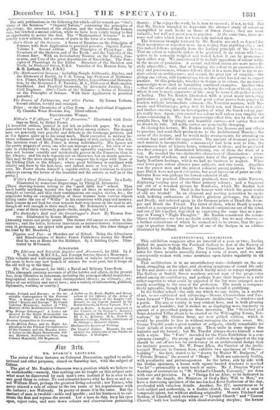ARCHITECTURAL EXHIBITION.
This exhibition reappears after an interval of a year or two ; having shifted its quarters from the Portland Gallery to that of the Society of British Artists in Suffolk Street. The Committee have now taken the latter for three months annually during a term of years, and we may consequently reckon with some assurance upon future regularity in its displays.
That architecture is in an unsatisfactory state—lethargic on the one hand, struggling on the other, and showing symptoms of sound life only by fits and starts—is an old tale which hardly needs or repays repetition. The Gallery at Suffolk Street numbers several men of the progressive school among its contributors, and perhaps bears their impress in a ratio rather superior to what could be expected if the list were enlarged more nearly according to the area of the profession. The result is compara- tively agreeable, though it might be too much to call it gratifying. In the Gothic school—the only one which we can desire, as a matter of art, to see cultivated and advancing—Messrs. Chamberlain and Tab- berer forward "Three Details for Domestic Architecture "—windows and a porch. The aim at variety is very evident here, and is both pleasing in effect and laudable ; but it strikes us as displaying more ingenuity in pursuit of a prescribed purpose than invention. The " Detached and Semi-detached Villas about to be erected on the Willoughby Estate, Tot- tenham," by Mr. Charles Gray, arc neat gabled edifices, which it would be possible to live in without outraging the artistic sense. Mr. George Truefitt sends a great number of subjects, chiefly remarkable for their details of iron-work and so on. These unite in some degree the fantastic and the formal ; but Mr. Truefitt always shows himself a man with a style. The " Font" intended for the Paris Exhibition is a con- spicuous example ; the group of angels and children designed at the top should be cut off not less for irrelevancy in an architectural design than for intrinsic poorness. Mr. W. Bruce Allen, the Curator of the Archi- tectural Museum in Cannon Row, exhibits two specimens of " House- building" ; the first, stated to be "drawn by Master W. Dudgeon," of " Private Houses," the second of " Shops." Both are extremely Gothic, with peculiarity and picturesqueness. In the latter, side by side with the Gothic specimen, a house with square-headed windows is marked "to let"—presumably a neat touch of satire. Mr. J. Drayton Wyatt's drawings of restorations to "St. Michael's Church, Coventry," are done with care and precision. In a " Design for an Altar, to be dedicated in honour of the Angels, the Ministers of God's Holy Will to Men," we have a distressing specimen of the mechanical florid Gothicism of the day, overloaded with valueless details. Another, No. 277, anonymous as to both subject and authorship, is a Gothic church, the work of a man of competent talent, but without striking originality. Messrs. Prichard and Seddon, of Llandaff, send elevations of " Tynant Church" and " Canton Church," both low buildings with cloud-searching steeples ; the former




































 Previous page
Previous page